Michigan is the victim of numerous invasive species that affect the local wildlife and vegetation. Whether they were introduced on purpose or by accident, these species have really affected the local ecosystem. Thankfully, as we learn more about these invasive species and understand the consequences, many efforts are in place to help minimize their impact.
From flora to fauna, here is a list of some of the most common invasive species currently living in Michigan and wreaking havoc on the state’s ecosystem.

Keep reading to learn more about each of these invaders who are causing trouble in Michigan.
Spotted Lanternfly (Lacroma delicatula)
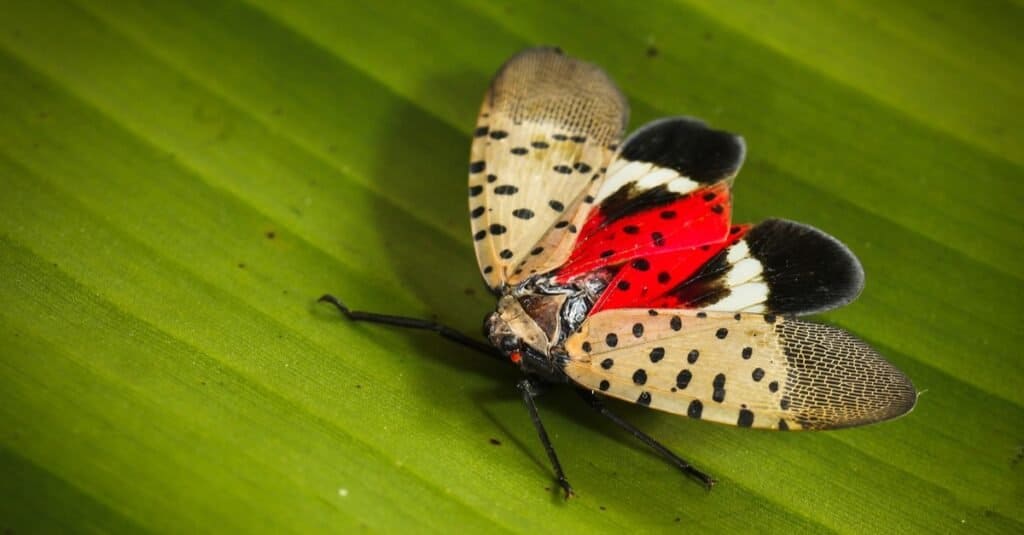
Spotted lanternfly infests economically significant plants making them an invasive species in Michigan,
©vm2002/Shutterstock.com
The spotted lanternfly is indigenous to parts of China and Vietnam. This insect has spread invasively to other parts of the world, including Japan, South Korea, and the United States. These little critters are around one inch long and half an inch wide. They are recognized by their wings which are gray-brown with black spots. Their heads are black in color. When these insects are resting, their crimson hind wings give them a red cast.
These insects are planthoppers and use their wings to help them jump from plant to plant. The tree that they most prefer is tree-of-heaven (Ailanthus altissima). However, these insects also infest economically significant plants such as soybean, grapes, and stone fruits. Because of this, this species is known as one of the invasive species in Michigan. In their native habitat, parasitic wasps keep the spotted lanternfly’s population in check.
Because these insects feed on crops and plants by sucking sap, this weakens and damages the plants they feed on. This can have devastating impacts on Michigan industries such as grape and logging. Currently, insecticides are being used to control the spotted lanternfly population. If you do see one of these critters in Michigan, make sure to report it!
Hemlock Woolly Adelgid (Adelges tsugae)
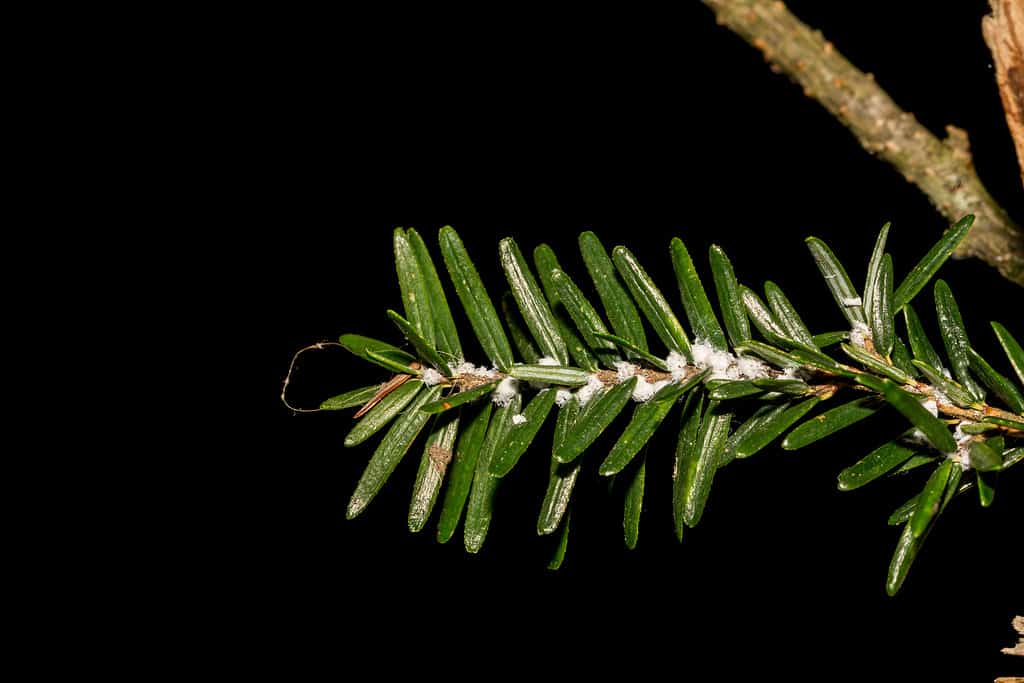
Hemlock Woolly Adelgid creates white sacks on trees and drains trees of nutrients.
©iStock.com/JasonOndreicka
The hemlock woolly adelgid is an insect that is native to Japan. This insect is considered invasive in North America as it threatens the eastern hemlock and the Carolina hemlock. An adult is oval and typically around 1/16 inch long. It is a dark reddish brown or a purplish black. An interesting fact about these small insects is that they can even inject a toxin while feeding.
As the name suggests, these insects feed on hemlock trees. In fact, these invasive forest insects have killed hundreds of thousands of hemlocks in the eastern United States. Today, the hemlock woolly adelgid threatens more than 170 million hemlock trees in Michigan forests.
In East Asia, the hemlock woolly adelgid feeds on Asian hemlock, which is resistant to the insect and does not sustain serious injury. There are also predators of the insect that help control the population. In the eastern United States, the hemlocks suffer a lot of damage with no natural methods to control the insect population. At this stage, insecticides are being used to help contain the population of the hemlock woolly adelgid. However, this method is not environmentally safe or cost-effective. Research is being done to see if a species of predatory beetles can be considered for release if needed.
Emerald Ash Borer (Agrilus planipennis)

Emerald ash borer feed on ash tree leaves, harming the ash trees in Michigan.
©Herman Wong HM/Shutterstock.com
The emerald ash borer is a beetle that is native to northeastern Asia. As its name suggests, this beetle feeds on ash species. These insects are easily recognized by their bright metallic green color. They are around 0.33 inches in length and 0.06 inches in width. The emerald ash borer is native to Russia, Mongolia, China, Japan, and Korea. The beetle is an invasive species in North America and has a core population in Michigan.
Adult emerald ash borers feed on ash tree leaves. The larvae of the insect feed on vascular tissue just under the ash tree’s bark – you can see S-shaped lines in the bark of the trees from the larvae. Their feeding habits are what makes these insects so destructive in North America. In their native habitat, some measures help keep the damage of the emerald ash borer low. They are generally found in low densities in these native ranges and do not cause significant damage to the trees in the area.
Unfortunately, North America does not have resistant trees, predators, and parasitoid wasps to control the population of the emerald ash borer. Therefore, these insects continue to reproduce, and populations rise to damaging levels. So far, this insect has killed tens of millions of ash trees and threatens to kill all other ash trees throughout North America. This can negatively affect the ecosystem and can decrease the number of native plants, change the nutrients in the soil, and affect native species that feed on ash. Control measures for these insects include diversifying tree species, insecticides, and biological control.
Asian Long-horned Beetle (Anoplophora glabripennis)

These Asian long-horned beetles’ larval feeding causes death in trees, disrupting the ecosystem.
©Heiko Kueverling/Shutterstock.com
Although the Asian long-horned beetle has not been reported in Michigan yet, it is high on the watch list in the state, so it’s definitely worth mentioning here!
The Asian long-horned beetle is a native species to Eastern Asia and was accidentally introduced into the eastern United States. The adults are quite large and range from 0.67 to 1.5 inches in length, with really long antennae that can grow up to 1.6 inches. They are recognized by their shiny black bodies with white spots on each wing cover. The antennae of the insect are also banded black and white.
You can find these insects on the leaves and bark of trees like maples, willows, and elms. In North America, maple is the most commonly infested tree genus. Infestation on the trees that the beetle inhabits is what makes these insects so destructive outside of their native range.
Larval feeding causes tree mortality which can change both forest and urban ecosystems. In the United States, these beetles could destroy around 30.3% of urban trees, resulting in a $669 billion economic loss. Control measures include monitoring, quarantine, removal of infested trees, and biological control. Due to the measures that some of the states have taken to control the population of the Asian long-horned beetle, this beetle has been successfully eradicated in some states. Although not detected in Michigan, this beetle is on the watch list and is prohibited in the state. As early detection is key for eradication, if you see one of these critters, make sure you report it!
Didymo (Didymosphenia geminata)
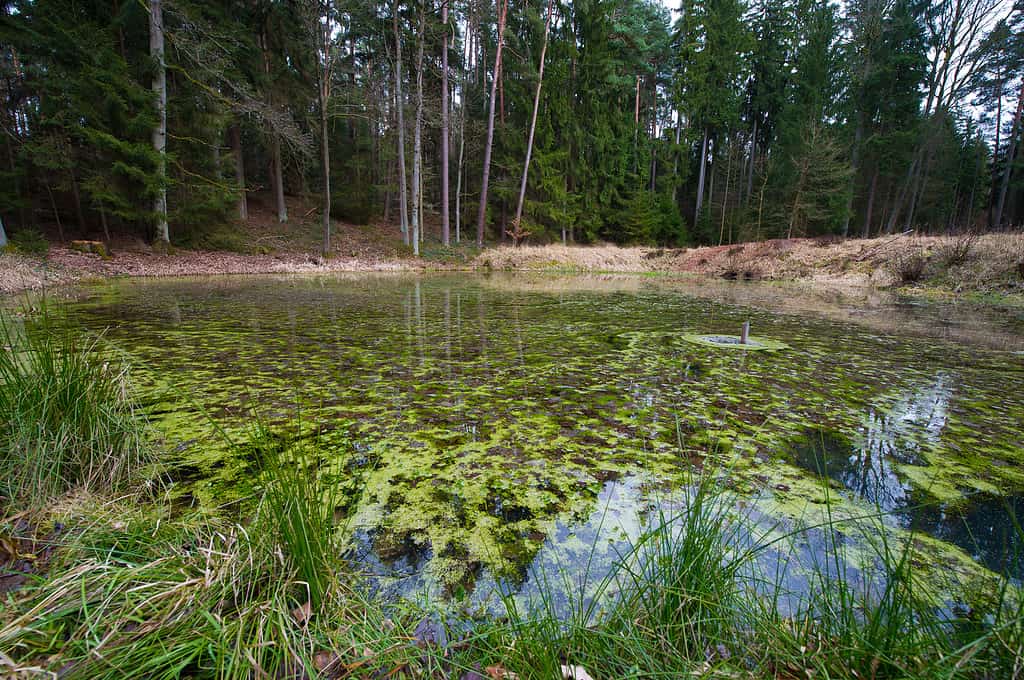
Didymo is a species of algae that is invasive to Michigan.
©iStock.com/Hopfphotography
The didymo, commonly known as rock snot, is a species of algae native to the northern hemisphere. Although this species is native to parts of North America, there have been reports of excessive growths that have turned these algae into a nuisance species. In Michigan, this species is considered an invasive species. This species thrives in low-nutrient cold water rivers and streams.
This organism is a singular-celled organism with silica cell walls. It produces stalks that can attach to rocks, plants, or other surfaces. The cell itself is not the nuisance, but it is the massive production of extracellular stalks. It looks and feels like wet wool and is white or brown in color.
This invasive alga is a problem as it outcompetes native algal species, alters stream ecology, and impacts the insects that are important food sources for fish. This species can spread from a single drop of water, so it is extremely important to implement control measures. Although there are no effective measures to eradicate didymo, there are measures that you can take to ensure you do not help spread the organism, including draining water from all equipment and drying all of your gear.
Giant Hogweed (Heracleum mantegazzianum)

The giant hogweed is one of the invasive species in Michigan because of the plant’s toxicity.
©iStock.com/hapelena
Giant hogweed is a herbaceous plant that is native to Eurasia. This plant can grow from 6 ft 7 inches to 16 ft 5 inches. In ideal conditions, this large plant can grow to 18 feet. They can grow very large lobed leaves between 3 ft 3 inches to 4 ft 11 inches wide. The stem is bright green and stout with dark reddish-purple splotches and coarse white hairs. The flowers produced are white or greenish-white.
The sap of the giant hogweed is phototoxic and can cause photodermatitis. They can cause blisters and scars in humans, making them a noxious weed. In fact, the sap can cause a severe burn within 24 to 48 hours! Contact with the eyes can cause temporary to permanent blindness. This plant is so toxic that it is found on the federal noxious weed list. This means selling or transporting the plant across state lines is illegal.
Control measures for the giant hogweed include root cutting, flower head/seed head removal, and cutting and mowing. The most effective method is root cutting. Herbicides are also used as a control measure for these invasive plants. Unfortunately, there is no longer any funding to the Michigan Department of Agriculture and Rural Development to control giant hogweed. Instead, it is up to the owner/manager of the sites where giant hogweed is known to occur to manage.
Mute Swan (Cygnus olor)
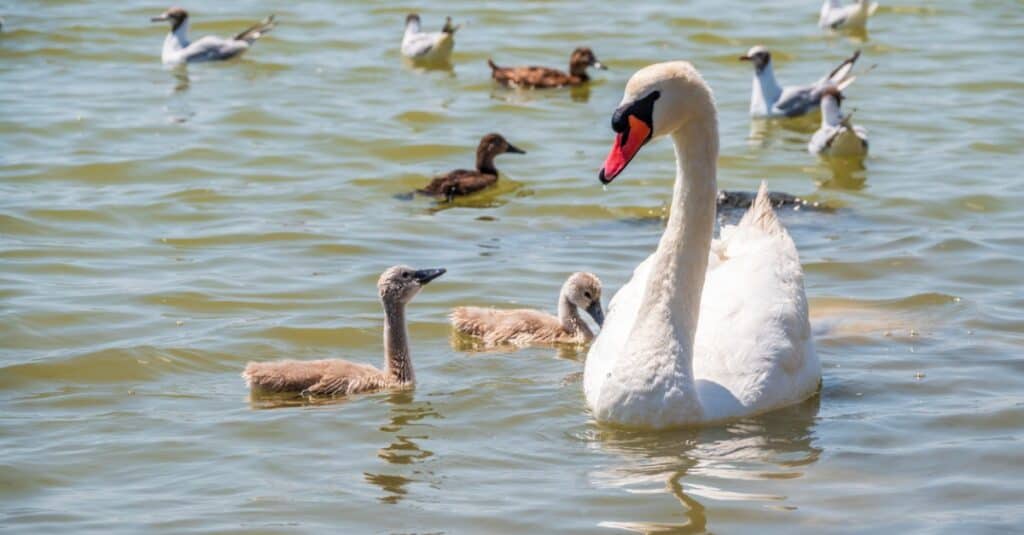
Due to their aggressiveness and large appetite, mute swans are on the list of invasive species in Michigan.
©iStock.com/Dmitry Potashkin
The mute swan is native to Eurosiberia and is an introduced species in North America. It is named as such because it is less vocal than other swan species. This large swan is white with an orange beak bordered with black. The pronounced knob on top of the beak makes these swans distinguishable from others. Adults can grow between 55 to 63 inches in length with an 80 to 95-inch wingspan. The mute swan is actually one of the heaviest flying birds, with males weighing between 20 and 32 lbs.
Mute swans prefer to live in well-sheltered bays, lakes, ponds, and open marshes. These birds feed on aquatic vegetation as well as small amphibians, mollusks, insects, and worms. Mute swans are also one of the world’s most aggressive waterfowl species. This is a concern as they will chase native breeding birds from their nests.
The mute swan is considered an invasive species in Michigan for three reasons. The first is that they are aggressive and chase away native breeding birds. The second is that they consume a large number of plants in a day. This destroys food sources for native birds and covers for native fish and invertebrates. Continuous feeding can also destroy an entire wetland ecosystem! Lastly, these birds do not fear people. There have been reports of attacks on people. Although you are not allowed to hunt these swans, you can request permits to remove mute swans and their nests and eggs.
Zebra Mussel (Dreissena polymorpha)

Zebra mussels lay one million eggs annually, making them one of the top invasive species in Michigan.
©iStock.com/VitalisG
This small freshwater mussel originates from the lakes of southern Russia and Ukraine and has become a common invasive species in most countries across the world, including Michigan. They were first discovered in Lake Michigan in the late 1980s, and since then, their population has exploded in size. However, in the last 15 years, their numbers have plummeted drastically, coinciding with the rapid growth of another invasive species: the quagga mussel.
Zebra mussels are tiny in size, measuring an average of only one inch long. They have a distinctive striped pattern on their shell consisting of lighter and darker browns. They are filter feeders and feed by filtering water through their bodies to collect any plankton or other small organisms that may be floating.
Zebra mussels are considered invasive because they can reproduce very rapidly, laying up to one million eggs annually! This takes a massive toll on the native wildlife populations as they outcompete for food and habitat. Another reason is that they have hard and sharp shells which pose a danger to swimmers.
Physical removal of the mussels proves to be the best control measure in place, as well as the use of barriers to stop their spread to other waterways. Informing the public about these pests and encouraging checks and cleaning of boats and other water equipment is also an important part of keeping the zebra mussel contained.
Rusty Crayfish (Faxonius rusticus)

Crayfish in Michigan enjoy freshwater and can be found in rocky areas in the water.
©iStock.com/BZH22
Native to Ohio, rusty crayfish were introduced into Lake Michigan in the 1960s or early 1970s. Since then, they have spread across many of Michigan’s waterways. This freshwater crayfish is colored with dark brownish-red backs and sides, with pale greenish-brown claws and legs. They can reach sizes up to four inches long and weigh between 0.88 to 1.76 ounces.
Rusty crayfish are usually found in rocky areas with clear water and will eat a variety of both plants and animals, including snails, insects, other crayfish, and aquatic plants. They live in communities with other rusty crayfish, where the largest male will assert dominance over the others.
These crayfish are considered invasive because they are rather aggressive, which makes them harder to be preyed upon by the native fish populations. Many of the native crayfish populations have seen a huge decline over recent years, finding it hard to compete with the rusty crayfish for food and habitat.
Control efforts for the rusty crayfish have included chemicals that only affect crayfish. Unfortunately, this method does not specifically kill the rusty crayfish but rather all species of crayfish. A better method involved promoting the catching of rusty crayfish for food. However, this only affects the adult population. Overall, once the rusty crayfish has established itself, it is very hard to eradicate them. The most effective way to control the population is to educate people on safer cross-contamination practices between bodies of water that host these invasive crayfish.
Asian Carp (Cyprinus carpio)
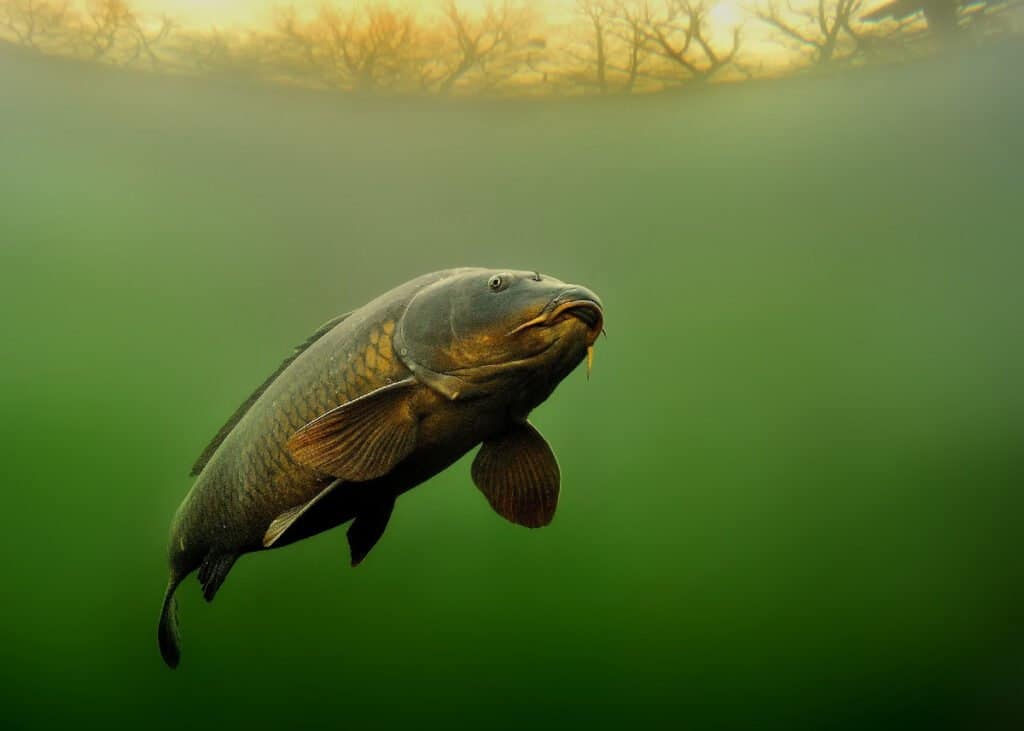
Asian carp is an invasive species because they eat large amounts of food, leaving very little for other fish.
©Martin Pelanek/Shutterstock.com
There are many different species of carp in the Asian carp family, including silver carp, bighead carp, and black carp, all of which can be found invading the waterways of Michigan. These fish are native to Asia and were introduced to the southern United States during the 1970s and 1980s to control algae growth in their aquaculture ponds and have since spread across the continent.
Asian carp come in a range of sizes, with bighead carp weighing over 100 pounds and measuring four feet in length. Silver carp weigh up to 60 pounds and measure around 3 feet in length. Lastly, black carp can weigh up to 33 pounds and measure up to 5 feet long. These fish are filter feeders and will eat small organisms like plankton, and algae, using their long gill rakers.
Asian carp are considered to be an invasive species in Michigan due to their ability to eat large amounts of food, which leads to less food available for the native fish species. In addition, their large size and tendency to jump up and out of the water pose a threat to boaters who may collide with these airborne fish. Physical barriers such as screens or electric fences are used in Michigan to help control the spread of Asian carp. There are also control measures in place to control their population, such as encouraging commercial fishing of the species to reduce their numbers.
Round Goby (Neogobius melanostomus)
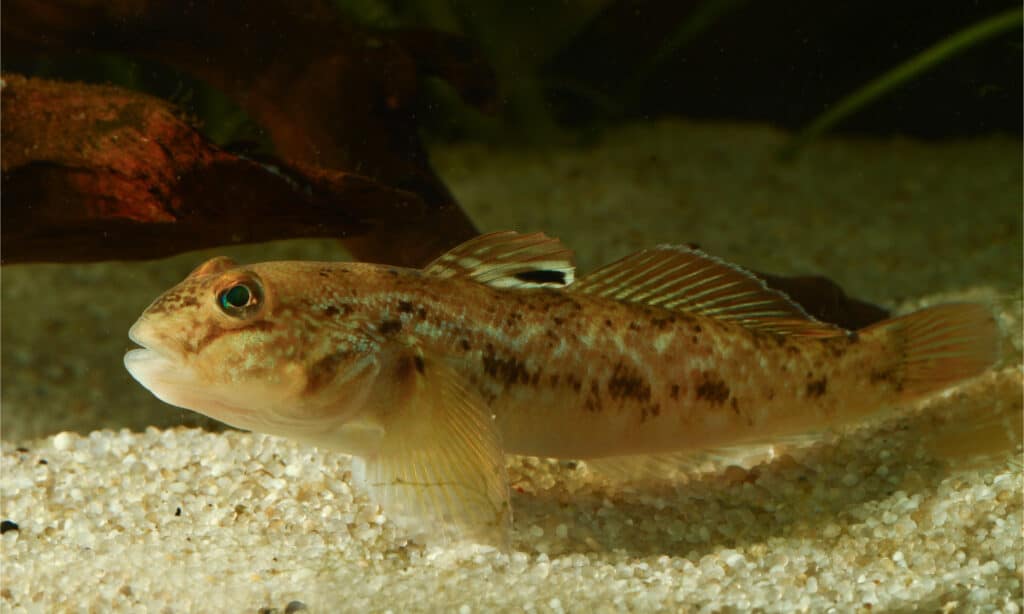
There are invasive colonies of round gobies in America’s Great Lakes, including in Michigan.
©Geza Farkas/Shutterstock.com
The round goby originally comes from the Black Sea and Caspian Sea regions of Eastern Europe and Western Asia and has established itself in Michigan waters. Round gobies are small fish that grow to an average of six inches long. They have a flat body with a large head and mouth and raised eyes. They are covered in brownish-gray scales and have a distinctive black spot on their dorsal fin.
Round gobies can be found in Lake Michigan, where they have few natural predators, allowing them to thrive. They feed on small fish and their eggs, including their own!
Round gobies are considered to be an invasive species in Michigan because they prey on the eggs of the native fish population, and compete for food and habitat causing a decline in certain species. This has a negative impact on the aquatic ecosystem.
To control the spread of these invasive fish in Michigan, measures are in place to monitor populations, implement regulations on the release of ballast water from ships, educate the public about the risks these fish carry, and even encourage catching them for food. However, despite these efforts, controlling the spread and impact of these invasive species remains challenging.
The photo featured at the top of this post is © Bennian/Shutterstock.com
Thank you for reading! Have some feedback for us? Contact the AZ Animals editorial team.






